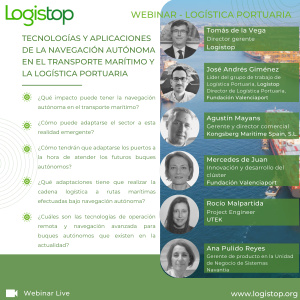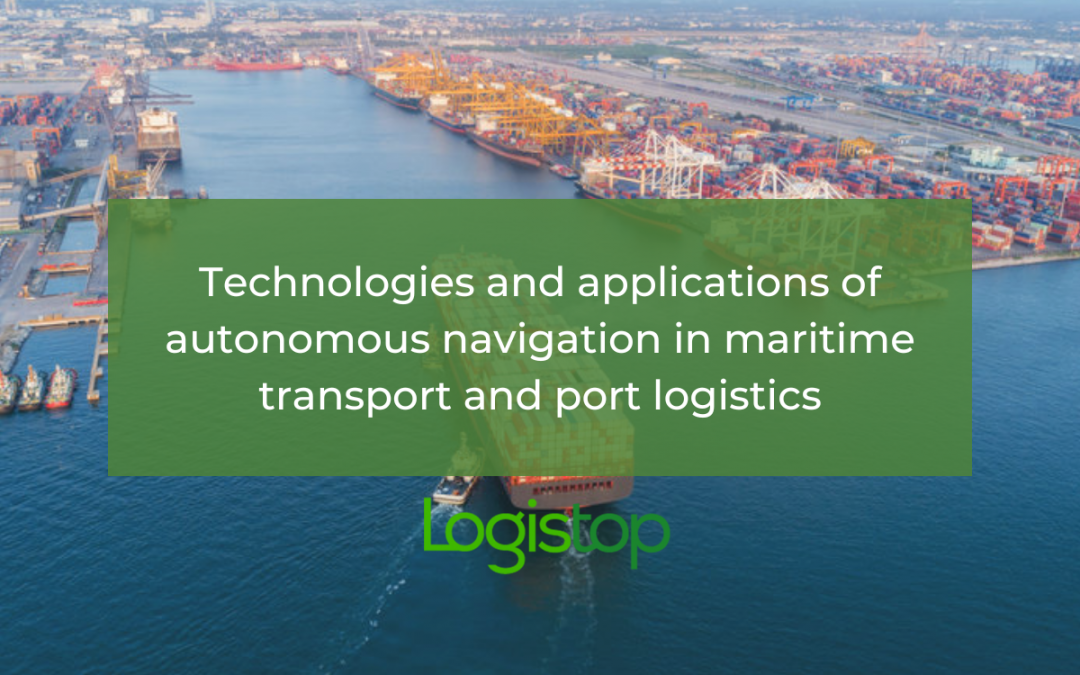- Technologies for maritime aids to navigation are undergoing significant development.
- Connectivity is one of the main challenges associated with these technologies.
- Unmanned vessels have great advantages over conventional vessels.
In the Logistop Webinar “Technologies and applications of autonomous navigation in maritime transport and port logistics”, the latest trends, projects and initiatives related to the development of autonomous navigation and its applications in maritime transport and ports were presented.
To know different types of views on the applicability of these technologies we have counted with the participation of José Andrés Giménez, Leader of the Port Logistics working group, Logistop, and Port Logistics Director, Fundación Valenciaport, Agustín Mayans, Manager and Commercial Director, Kongsberg Maritime Spain, S.L., Mercedes de Juan, Innovation and Cluster Development, Fundación Valenciaport, Rocío Malpartida, Project Engineer, UTEK, Ana Pulido Reyes, Product Manager in the Systems Business Unit, Navantia, as well as with the presentation and moderation of Tomás de la Vega, Managing Director, Logistop.

To introduce the topic to be discussed, José Andrés Giménez highlights the important development that technologies oriented towards aids to maritime navigation have undergone in recent years. Similar to other sectors, such as autonomous driving of road vehicles, the application of these new technologies opens up a range of possibilities. The progress and evolution of these technologies, beyond the tests already carried out, has enabled their application and the performance of real tests in different environments; in some cases even offering the possibility of carrying out autonomous navigation in the open sea and unassisted manoeuvres in ports.
“In recent years, technologies aimed at aids to maritime navigation have undergone a very significant development, allowing their application and real tests to be carried out in different environments”
José Andrés Giménez, Port Logistics Director, Fundación Valenciaport
Remote operation and advanced navigation technology for autonomous ships
Agustín Mayans then introduced the main challenges associated with these technologies, which are linked to the following areas: connectivity and cybersecurity; situational awareness systems; autonomous machine systems; autonomous navigation systems; simulation and data analysis; remote operation; and shore-based control centre.
Among the aforementioned challenges to be faced, Agustín highlighted that connectivity is the first challenge to be faced and the most difficult to complete due to the need for the vessel to be permanently connected in real time without latency. He added that one of the main problems of autonomous navigation in this aspect is the coverage of the connection systems, which the higher the frequency, the shorter the range.
“The application of autonomous technologies is significantly easier when the simulation capability (with real data) is available prior to the action”
Agustín Mayans, Manager and Commercial Director, Kongsberg Maritime Spain, S.L.
MOSES Project “AutoMated Vessels and Supply Chain Optimisation for Sustainable Short Sea Shipping”
Mercedes de Juan then focused on the challenges related to autonomous technologies that they have addressed (and are addressing) through the MOSES project. This project, as detailed by Mercedes, exemplifies the complexity involved in the possible manoeuvring of a vessel which, in turn, is assisted by other autonomous service vessels within a port, through the use of emerging technologies.
One of the main challenges of autonomous systems training is that they have to coexist with other operations and circumstances taking place simultaneously in a port with high vessel traffic. In order to know the position of the vessel relative to others sailing in the vicinity or with respect to the quays, the artificial intelligence has to analyse information coming from radars, AIS, the traffic control centre, the cameras of the tugboats on board or those in the port, and so on.
“It is vital to have control of the vessel at all times, which requires all communications between all the actors involved (tugs, pilots, port authority, maritime traffic control, etc.) to be in real time”
Mercedes de Juan, Innovation and Cluster Development, Fundación Valenciaport
Unmanned solutions for port applications
For her part, Rocío Malpartida detailed and highlighted the wide variety of existing applications within the port environment. These different applications that have been implemented have allowed them to identify that unmanned vessels have great advantages over conventional vessels, which is why they are proving to be very useful for solving problems encountered in port operations.
She also highlighted the different fields of application, both in the defence and civil fields, of these unmanned vehicles, also identifying a series of payloads (water sensors, hydro-acoustic systems, lidar, camera towing systems, drones, etc.) to fulfil these applications and missions.
“Unmanned vessels have great advantages over conventional vessels, proving to be very useful in solving problems encountered in port operations”
Rocío Malpartida, Project Engineer, UTEK
The USV VENDAVAL vessel in service at the Port of Ceuta
Finally, Ana Pulido presented the USV Vendaval vessel, which has been operating in the Port of Ceuta since 2019 and whose main missions are port surveillance and security, on the one hand, and environmental control, on the other. Due to current regulations, as Ana emphasises, it is a dual-use vehicle, so it can be both manned and unmanned.
The idea of including this type of vessel in the surveillance system arises from the many advantages that this type of vehicle offers, including minimising human exposure to risk situations, multiplying operational capabilities, increasing speed and extending availability in time, as well as reducing resources and operating errors, among other factors.
“The USV Vendaval is a response to a series of requirements in terms of international and environmental commitments, as well as to new security threats to which the Port of Ceuta must respond”.
Ana Pulido Reyes, Product Manager in the Systems Business Unit, Navantia
About Logistop
Logistop is the benchmark workspace for collective innovation through the realisation of projects hand in hand with our members. Transforming the entire supply chain into a more efficient and sustainable one. All this with the aim of articulating and carrying out innovation projects among the members, without excluding the possibility of collaborating with or receiving support from certain organisations outside Logistop.

